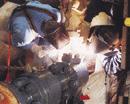
When time and space are tight, equipment portability equals improved productivity
If you discovered your employees were spending 87 percent more time and money than necessary to do a simple task, would you fire your workers? But, what if you found out it was your welding equipment's fault? Would you fire your equipment instead? That's exactly what Jim Hennessy, Quality Coordinator for AZCO Inc. did, and the new equipment has helped this integrated industrial construction contractor reduce downtime and improve productivity, particularly on a recent boiler project.
In May 2000, Alliant Energy began a three-week scheduled shut-down of Boiler #4 at the Edgewater Generating Station in Sheboygan, Wisconsin. Alliant, which owns Edgewater and several other coal-fired power plants in four states, conducts continuous testing of its boiler tubes, parts and related equipment. When digital thickness or ultrasonic testing detects tube wall thicknesses approaching the boiler manufacturer's minimum wall thickness, Alliant schedules a shut-down for maintenance and tube replacement.
By scheduling maintenance during the lower peak demand times for electricity — primarily in the Spring and Fall — Alliant prevents unexpected power outages and potential dangers due to boiler malfunction, as well as extends the life of the boiler. However, Alliant loses hundreds of thousands of dollars in viable power generation every day that an Edgewater boiler is down. That's why workers must adhere strictly to the tight schedule.
To perform the maintenance work, Alliant hired AZCO (Appleton, Wisconsin), which has the proper stamps mandated by the Power Boilers, ASME Section I, Boiler and Pressure Vessel Code.* To complete the job on time, AZCO demanded that two 10-hour shifts of employees at Edgewater — including 85 ASME IX certified welders — equipment.
For previous boiler jobs, AZCO utilized a 4,000 lb. multiarc welding unit with a 72 x 40 in. footprint. The unit allowed eight operators to weld independently from a single machine. While the multiarc unit has a lower acquisition cost-per-arc than eight individual welding power sources, the size and weight were not suited to the space constraints of boiler work. Having had success with the XMT® 304 multiprocess, inverter-based welding power source in both shop and field work, AZCO turned to Miller Electric's XMT® 304 Rack, which houses four individual and removable XMT units.
XMT Rack vs. Multiarc Unit
“When we got the XMT Racks, it was a Godsend,” says Aaron “AJ” Johnston, Project Field Superintendent at AZCO. “The XMTs are good, small machines. We have so many tight areas to get into, and the closer you can get the machine to where you are working, the better it is.”
To move the large multiarc unit, AZCO usually had three workers spend an entire shift opening up numerous floor gratings, using cranes and fork trucks to lift and move the multiarc units, replacing the grating and then rewiring the machines. This process also disrupted the work of many other workers.
The XMT Rack is 34 x 43 in. and weighs only 560 lb., so it maneuvers easily through the boiler's narrow grated walkways and it fits on a standard passenger elevator. The entire XMT Rack moving and rewiring process only takes two hours for two employees, thereby saving substantial time and labor costs versus that needed to move a multiarc unit (see chart).
“The welders are often working on more than one floor of the boiler in a day,” says Hennessy. “To avoid moving the unit whenever possible, they used to find a central spot and then string thousands of feet of cable between themselves and the multiarc unit. With the XMT Racks, they can move the power sources into the areas where they are working.”
The XMT Rack is also more convenient when maintenance is required. Operators all weld independently on both the larger multiarc unit and XMT Rack, but when a single welding module needs replacement for repair on the multiarc unit, the entire unit must be shut down for hours. That leaves eight workers idle, resulting in constraints on the project schedule.
“The XMT 304s are very durable, so we don't often have to take them in for maintenance. But in the rare occasion that an XMT goes down,” says Hennessy, “we just remove the one power source and replace it. The other three keep running, and there is no interruption.”
How the Boiler Works
Boiler #4, one of three at the Edgewater facility, is a 300 megawatt, Babcock & Wilcox coal-burning, cyclone boiler. It's called a cyclone because once the coal furnaces heat the air, the airflow swirls through seven cyclone air ducts, creating enormous turbulence. The air goes through primary, secondary and reheat superheaters where it heats and reheats water in a series of tube sheets. Finally, it travels through air heater tubes and back into the furnace where it is heated again and recirculated through the entire boiler.
The heated water goes to the steam drum, which separates the moisture and turns the turbines. The turbine rotates the generator that creates the electrical power.
“Everything at Edgewater is designed to ultimately run the generators,” notes Lloyd Weber, Alliant's Recurring Projects Engineer. “People don't realize what goes into generating the energy so they can do something as simple as turn on a lamp.”
Replacing Superheat Tubes
Alliant's ongoing non-destructive examination (NDE) testing and structural evaluations lead to biannual maintenance shut-downs of Edgewater's boilers. A boiler is made up of over 20 different materials and dozens of thicknesses, ranging from 1/16 to 2 inches (.120 to .420 in. thicknesses in the tubes). The higher heat areas of the boiler, like the elements, are made of high chromium steel to handle the heat. Water wall panels, which are the coolest part of the boiler, are made of carbon steel in nominal thicknesses.
By far the most critical part of the boiler repair process is tube welding because of the high temperature, high pressure conditions it must endure (turbine steam condition pressure is 2,400 psig and temperature is 1,000 degrees Fahrenheit). The walls of the tubes, especially in the lower ends of the turns, begin to wear away because of the steam or other products running through them, so they need regular replacement. Each boiler has thousands of feet of tubing for air and water flow.
The new tubes, which are made of .203-in. thick, T1A chrome-moly, have a stainless tube shield on the bends because there is more concentrated heat, or more cyclone effect, in this area, which can lead to excessive erosion. Stainless better resists erosion and protects the tube from the boiler's internal cyclic atmospheres.
To install tubes in a superheat, welding operators from Boilermakers Local 107 out of Milwaukee weave through the tight spaces between the tube sheets, sometimes less than 12 inches, and weld on their backs or in other contorted, less-than- ideal positions. Using approved and qualified AZCO Welding Procedure Specifications (WPSs), the operators TIG weld the root pass with ER80S-B2 filler metal and argon shielding gas, followed by a Stick cap with an E8018-B2 electrode.
Because tight conditions often leave operators with poor access to all sides of the joint, two Boilermaker welding operators often perform a Òbrother-in-lawÓ weld. During a “brother-in-law,” one operator passes his arc to another operator's electrode without interrupting the flow of the weld. To perform it correctly, the operators must work in harmony like they are family. This method is more efficient than stopping the arc to reposition for a better angle and it produces a better quality weld.
The XMT 304 allows operators to make very small current adjustments when TIG welding. This produces a smooth and stable arc, which gives operators full control over the weld puddle. The inverter's high operating frequency provides finer power increments, which allows output power to be more precisely controlled.
“The XMT has a good fine-tune setting for tube work in particular,” says Johnston. “And the arc is fantastic. It's more stable than anything we've had before. The last welding unit fluctuated tremendously. When we need to perform x-ray quality tube welds, the smoother the arc, the better it is for us. It turns out right the first time.”
The safety relief valves at the very top of the boiler were also replaced. The relief valves let out excess steam if the boiler exceeds its maximum pressure. Journeymen welders from Pipefitters Local 400 in Appleton working on the 2-1/4-in. inside diameter valve required 35 Stick passes to weld each joint due to its thickness.
Benefits of Multiprocess
When it is easier to remove a part to repair it, AZCO takes parts back to the shop. There, AZCO has its welding stations set up with the same XMT 304 units housed in the rack.
“We can use it for GTAW (TIG), SMAW (Stick), GMAW (MIG), FCAW (flux cored), even CAC-A (air carbon arc gouging),” says Hennessy. “The XMT is the all-around versatile machine. It can be used in any application we throw at it, from welding razorblades to battleships. We're not limited to a couple of processes.”
To encase the boiler after repair, AZCO MIG welded the membranes between the tubes and the tube sheets.
“To change to MIG, we just flip a switch on the XMT,” says Hennessy. “We used to bring in a dedicated CV machine. Now, we can hook up a Miller Super S-32P voltage sensing feeder to the XMT and go.”
By having one standard, multiprocess welding unit in the shop and field, AZCO's welding operators don't have to reacclimate themselves to a new unit every time they weld, thus reducing start-up time.
With all the success AZCO has experienced with the XMT 304 over the years, Hennessy's recommendation to other companies is really no surprise. “People in the industry who aren't taking advantage of the XMT 304's capabilities are missing an opportunity to enhance productivity and efficiency.”
© 2002 Miller Electric Mfg. Co


